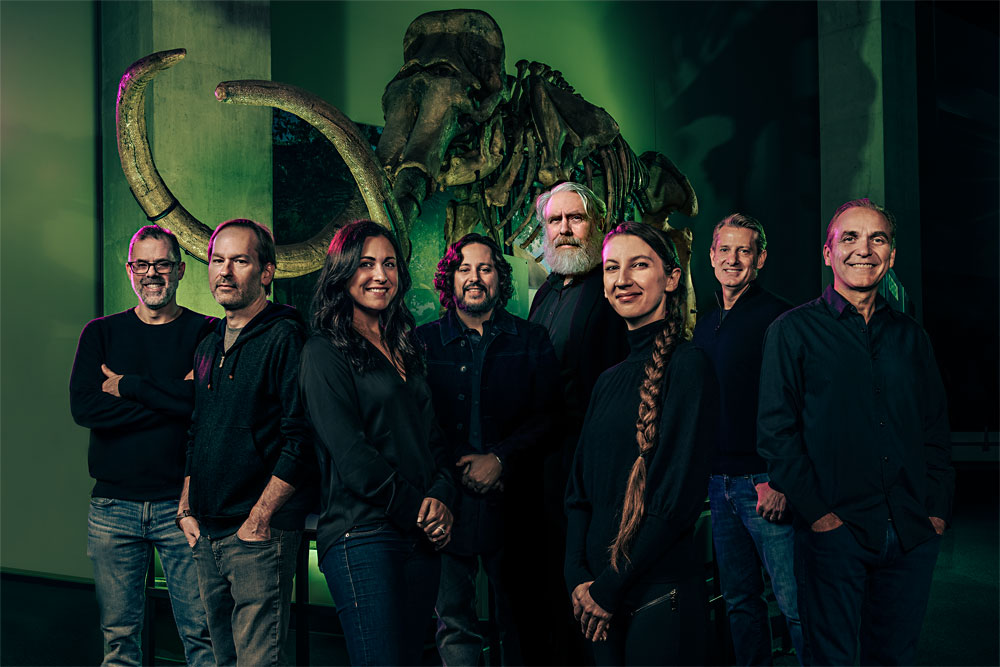The team behind Colossal, the firm that wants to bring back the woolly mammoth (Photo by John Davidson)
One small step for Mammuthus primigenius, one giant leap for humankind.
Tell the world your bioscience startup raised $75 million for renowned genomics pioneers to resurrect woolly mammoths, and you’re likely to get a plethora of comparisons to Jurassic Park. Factor in that some of the investors include former Legendary Entertainment CEO Thomas Tull and early Mark Zuckerberg rivals the Winklevoss twins, in addition to fears among some in society that dislike genetically modifying anything, and you’ll also get a lot of questions asking why we should embrace de-extinction at all.
However, that’s exactly what Austin startup Colossal plans to do, by inserting mammoth genetic information into existing species of African elephants so that they share many of the traits of their distant woolly cousins, like cold-weather resistance. The idea is that reintroducing mammoths to their former habitat in the arctic tundra would have ecological benefits to curb the effects of global warming. The company expects to have a living hybrid mammoth calf within a few years.
But the firm’s leadership doesn’t see this as some fringe science ploy to erect prehistoric zoos, nor is the classic Spielberg film an accurate comparison. Founder Ben Lamm compares the previously improbable, never-before-done task to ”the moon landing and the Apollo program. The path to bringing back the mammoth is similar [because] there are no technology or science gates to achieve it.” He noted that even 1960s technology was able to successfully travel to the moon and back, “and there’s a lot of technologies that will come out of [this work] that are massively disruptive, like Apollo.”
“You’re seeing the advancement of synthetic biology and genetic engineering at a phenomenal rate right now.” – Ban Lamm
America’s mission to land on the moon did indeed bring major new innovations, such as GPS, fireproof materials, the insulin pump, shock absorbing sneakers, integrated circuits, and so much more. Meanwhile, Colossal’s pursuit of resurrecting a mammoth will not just benefit the field of de-extinction, although the technologies can be applied to help save other endangered species. But that’s not all. Some of the innovations could even be applicable to agriculture and/or human health.
On the software side, Colossal co-founder (and occasional sci-fi novelist) Andrew Busey is leading efforts out of Austin to build a more standardized approach to using and sharing genomic data, which is badly needed to enhance collaboration and eliminate time used to normalize that information and edit genes. Then there’s the wetworks side, which is far cooler and exciting once you realize the impact it may have one day. For instance, the artificial womb Colossal’s developing to incubate the mammoth hybrids could one day be game-changing for premature births in human parents.
“Some of the technologies that we’re developing will help make genetic engineering faster, more efficient, and more impactful by doing multiple genes at the same time,” he said. For scale, Lamm’s co-founder George Church, the preeminent geneticist who helped develop CRISPR, began making one edit to a genome at a time via his lab and now holds the record at 24,000 (multiplex) edits in a single human cell. “So that’s only in a six-year timeline. You’re seeing the advancement of synthetic biology and genetic engineering at a phenomenal rate right now.”
That said, time probably isn’t the best benchmark for such precise work. And it is extremely precise, which is why Colossal hopes its technology will one day help provide full libraries of genomic data for most species, in service to genetic engineering.
”Anything is possible, potentially, with the tools available in learning how to expedite evolution [with other species],” said Head of Biological Sciences Eriona Hysolli. “But I would also caution that studies are needed to make this happen. If you want to turn a species into a different species, a lot more work needs to be done.” In other words, Colossal isn’t doing any radical engineering of species, thus you’ll just have to open a book if you want details about zebras with wings and lizard tails.
Hysolli also thinks this is why the work being done on the mammoth project is more ideal initially than other still-living animals: “This is just one more way we learn from evolution, by [observing] species that existed before like the woolly mammoth.” Even if arctic rewilding of these ancient beasts wasn’t part of a larger long-term mission for the company, she said there is plenty to discover to understand more about what is affecting endangered animals like elephants.
“I’m very passionate about climate change and species preservation. Those are two major themes in what we’re doing,” Lamm said. “But a lot of people just talk about arctic rewilding, and we’ve been very transparent: We’re stoked about it, but it’s gonna take a while.”
The startup’s preferred location for eventually reintroducing mammoths to the wild is Pleistocene Park, a nature reserve located in Russia-controlled Siberia. Given Russia’s recent invasion of former soviet territory Ukraine, taking a while might not be such a bad thing. And who knows, perhaps one day prominent American genomic researchers might even be among the most effective diplomatic connections to Russia in the same way the space program has been in modern times.
Featured Session
Colossal Mission: A Case for De-Extinction
Friday, March 18, 2:30pm, Convention Center
Credit: Source link




